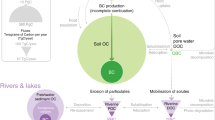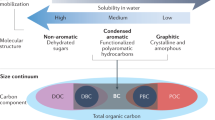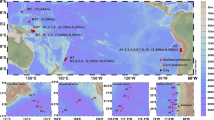Abstract
Humans have used fire extensively as a tool to shape Earth’s vegetation. The slash-and-burn destruction of Brazil’s Atlantic forest, which once covered over 1.3 million km2 of present-day Brazil and was one of the largest tropical forest biomes on Earth1, is a prime example. Here, we estimate the amount of black carbon generated by the burning of the Atlantic forest, using historical records of land cover, satellite data and black carbon conversion ratios. We estimate that before 1973, destruction of the Atlantic forest generated 200–500 million tons of black carbon. We then estimate the amount of black carbon exported from this relict forest between 1997 and 2008, using measurements of polycyclic aromatic black carbon collected from a large river draining the region, and a continuous record of river discharge. We show that dissolved black carbon (DBC) continues to be mobilized from the watershed each year in the rainy season, despite the fact that widespread forest burning ceased in 1973. We estimate that the river exports 2,700 tons of DBC to the ocean each year. Scaling our findings up, we estimate that 50,000–70,000 tons of DBC are exported from the former forest each year. We suggest that an increase in black carbon production on land could increase the size of the refractory pool of dissolved organic carbon in the deep ocean.
This is a preview of subscription content, access via your institution
Access options
Subscribe to this journal
Receive 12 print issues and online access
$259.00 per year
only $21.58 per issue
Buy this article
- Purchase on Springer Link
- Instant access to full article PDF
Prices may be subject to local taxes which are calculated during checkout



Similar content being viewed by others
References
Fundação SOS Mata Atlântica and Instituto Nacional de Pesquisas Espaciais. Atlas dos remansecentes florestais da Mata Atlântica, período 2008–2010. (INPE and SOS Mata Atlântica, 1993 and 2011).
Warren, D. With Broadax and Firebrand. The destruction of the Brazilian Atlantic forest (Univ. California Press, 1995).
Forbes, M. S., Raison, R. J. & Skjemstad, J. O. Formation, transformation and transport of black carbon (charcoal) in terrestrial and aquatic ecosystems. Sci. Total Environ. 270, 190–206 (2006).
Schmidt, M. W. I. et al. Soil organic matter persistence as an ecosystem property. Nature 478, 49–56 (2011).
Masiello, C. A. & Druffel, E. R. M. Black carbon in deep-sea sediments. Nature 280, 1911–1913 (1998).
Kuhlbusch, T. A. J & Crutzen, P. J. Toward a global estimate of black carbon in residues of vegetation fires representing a sink of atmospheric CO2 and a source of O2 . Glob. Geochem. Cycles 9, 491–501 (1995).
Hockaday, W. C., Grannas, A. M., Kim, S. & Hatcher, P. G. Direct molecular evidence for the degradation and mobility of black carbon in soils from ultrahigh-resolution mass spectral analysis of dissolved organic matter from a fire-impacted forest soil. Org. Geochem. 37, 501–510 (2006).
Cheng, C-H. & Lehmann, J. Ageing of black carbon along a temperature gradient. Chemosphere 75, 1021–1027 (2009).
Abiven, S., Hengartner, P., Schneider, M. P. W., Singh, N. & Schmidt, M. W. I. Pyrogenic carbon soluble fraction is larger and more aromatic in aged charcoal than in fresh charcoal. Soil Biol. Biochem. 43, 1615–1617 (2011).
Kim, S., Kaplan, L. A., Benner, R. & Hatcher, P. G. Hydrogen-deficient molecules in natural riverine water samples—evidence for the existence of black carbon in DOM. Marine Chem. 92, 225–234 (2004).
Mannino, A. & Harvey, H. R. Black carbon in estuarine and coastal dissolved organic matter. Limnol. Oceanogr. 49, 735–740 (2004).
Guggenberger, G. et al. Storage and mobility of black carbon in permafrost soils of the forest tundra ecotone in Northern Siberia. Glob. Change Biol. 14, 1367–1381 (2008).
Dittmar, T. & Paeng, J. A heat-induced molecular signature in marine dissolved organic matter. Nature Geosci. 2, 175–179 (2009).
Lino, C. F. & Dias, H. Águas e florestas da Mata Atlântica: por uma gestão integrada (Conselho Nacional da Reserva da Biosfera da Mata Atlântica, 2003).
Hammes, K. et al. Comparison of quantification methods to measure fire-derived (black/elemental) carbon in soils and sediments using reference materials from soil, water, sediment and the atmosphere. Glob. Biogeochem. Cycles 21, GB3016 (2007).
Evans, C. & Davies, T. D. Causes of concentration/discharge hysteresis and its potential as a tool for analysis of episode hydrochemistry. Wat. Resour. Res. 34, 12–137 (1998).
Stubbins, A. et al. Illuminating darkness: Molecular signatures of Congo River of dissolved organic matter and its photochemical alteration as revealed by ultrahigh precision mass spectrometry. Limnol. Oceanogr. 55, 1497–1477 (2011).
Dittmar, T., Koch, B. P., Hertkorn, N. & Kattner, G. A simple and efficient method for the solid-phase extraction of dissolved organic matter (SPE-DOM) from seawater. Limnol. Oceanogr. 6, 230–235 (2008).
Dittmar, T. The molecular level determination of black carbon in marine dissolved organic matter. Org. Geochem. 39, 396–407 (2008).
Fearnside, P. M., Gráça, P. M. L. A., Filho, N. L., Rodrigues, F. J. A. & Robinson, J. M. Tropical forest burning in Brazilian Amazonia: Measurement of biomass loading, burning efficiency and charcoal formation at Altamira, Pará. Forest Ecol. Manage. 123, 65–79 (1999).
Gráça, P. M. L. A., Fearnside, P. M. & Cerri, C. C. Burning of Amazonian forest in Ariquemes, Rondonia, Brazil: Biomass, charcoal formation and burning efficiency. Forest Ecol. Manage. 120, 179–191 (1999).
Fearnside, P. M., Gráça, P. M. L. A. & Rodrigues, F. J. A. Burning of Amazonian rainforests: Burning efficiency and charcoal formation in forest cleared for cattle pasture near Manaus, Brazil. Forest Ecol. Manage. 146, 115–128 (2001).
França, H. Metodologia de identificação quantificação de áreas queimadas no Cerrado com imagens AVHRR/NOAA PhD thesis. Universidade de São Paulo, Instituto de Biociências, (2000).
Calazans, C. Origem e dinâmica da material orgânica em um sistema fluvio-lacustre da região norte Fluminense PhD thesis, Universidade Estadual do Norte Fluminense, Centro de Biociências e Biotecnologia. Campos dos Goytacazes, (1998).
Sanhueza, E. Potential emissions of Kyoto and non-Kyoto climate active compounds in the production of sugarcane ethanol. Interscience 34, 8–16 (1999).
Marinho, E.V.A. & Kirchhoff, V. W. J. H. Projeto fogo: um experimento para avaliar efeitos das queimadas de cana-de-açúcar na baixa atmosfera. Revista Brasileira de Geofísica 9, 107–119 (1991).
Doerr, S. H. et al. Effects of differing wildfire severities on soil wettability and implications for hydrological response. J. Hydrol. 319, 295–311 (2006).
Chafer, C. J. A comparison of fire severity measures: An Australian example and implications for predicting major areas of soil erosion. Catena 74, 235–245 (2008).
Vasconcelos, A. C. M., Casagrande, A. A., Perecin, D., Jorge, L. A. C. & Landell, M. G. A. Evaluation of the sugarcane root system with different methods. Revista Brasileira de Ciência do Solo 27, 849–858 (2003).
Bond, T. C., Street, D. G., Yarber, K. F., Nelson, S. M., Woo, J.-H. & Klimont, Z. A technology-based global inventory of black and organic carbon emissions from combustion. J. Geophys. Res. 109, 1–43 (2004).
Acknowledgements
This study was financially supported by Conselho Nacional de Desenvolvimento Científico e Tecnológico—CNPq (304.615/2010-2 and INCT Material Transfer at the Continent–Ocean Interface 573.601/08-9), Fundação de Amparo a Pesquisa do Estado doRio de Janeiro—FAPERJ (E-26/102.697/2008) and the Hanse Institute for Advanced Studies (HWK, Delmenhorst, Germany). Thanks to A. Antonio Rosa Gobo, M. Friebe and I. Ulber for technical support. Thanks to our colleagues at the United States Geological Service, E. G. Stets, R. G. Striegl and M. M. Dornblaser, R. G. M. Spencer (Woods Hole Research Center) and T. Riedel (University of Braunschweig) for advice on the hydrological modelling. Instituto Nacional de Meteorologia do Brasil provided meteorological data.
Author information
Authors and Affiliations
Contributions
The idea of this study was jointly developed by C.E.d.R. and T.D. All authors contributed to sampling, chemical analysis and/or data interpretation, and to the general discussion. T.D. led the writing of the manuscript and the drafting of the figures. All authors provided input into the drafting and the final version of the manuscript.
Corresponding authors
Ethics declarations
Competing interests
The authors declare no competing financial interests.
Supplementary information
Supplementary Information
Supplementary Information (PDF 513 kb)
Rights and permissions
About this article
Cite this article
Dittmar, T., de Rezende, C., Manecki, M. et al. Continuous flux of dissolved black carbon from a vanished tropical forest biome. Nature Geosci 5, 618–622 (2012). https://doi.org/10.1038/ngeo1541
Received:
Accepted:
Published:
Issue Date:
DOI: https://doi.org/10.1038/ngeo1541
This article is cited by
-
Sources and dynamics of dissolved black carbon in the Pearl River Estuary and Shelf, Northern South China Sea
Journal of Oceanography (2024)
-
Identifying photochemical alterations of dissolved pyrogenic organic matter using fluorescence spectroscopy
Aquatic Sciences (2023)
-
Biochar nanoparticles-mediated transport of organic contaminants in porous media: dependency on contaminant properties and effects of biochar aging
Carbon Research (2023)
-
Dissolved black carbon concentrations in suspended particulate matter from the Bohai Sea
Science China Earth Sciences (2023)
-
Methane emissions and rice yield in a paddy soil: the effect of biochar and polystyrene microplastics interaction
Paddy and Water Environment (2023)



